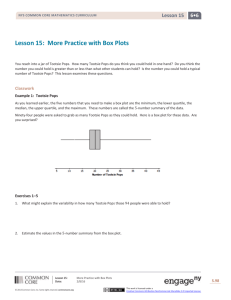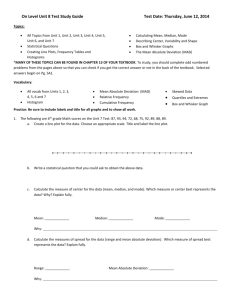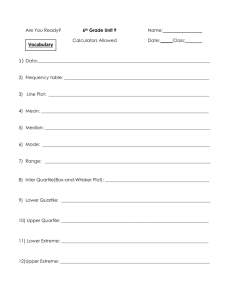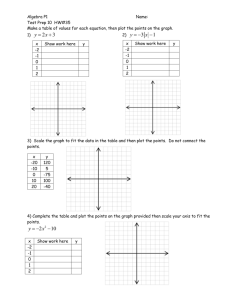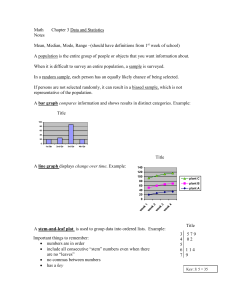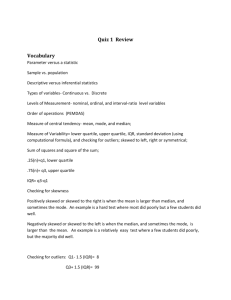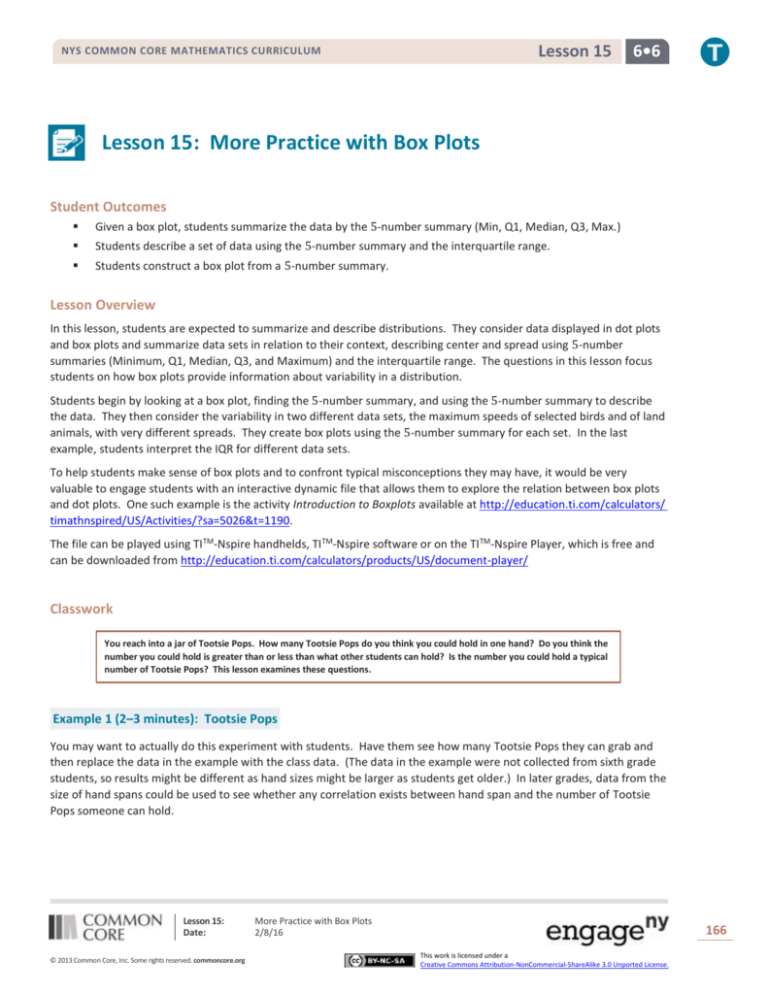
Lesson 15
NYS COMMON CORE MATHEMATICS CURRICULUM
6•6
Lesson 15: More Practice with Box Plots
Student Outcomes
Given a box plot, students summarize the data by the 5-number summary (Min, Q1, Median, Q3, Max.)
Students describe a set of data using the 5-number summary and the interquartile range.
Students construct a box plot from a 5-number summary.
Lesson Overview
In this lesson, students are expected to summarize and describe distributions. They consider data displayed in dot plots
and box plots and summarize data sets in relation to their context, describing center and spread using 5-number
summaries (Minimum, Q1, Median, Q3, and Maximum) and the interquartile range. The questions in this lesson focus
students on how box plots provide information about variability in a distribution.
Students begin by looking at a box plot, finding the 5-number summary, and using the 5-number summary to describe
the data. They then consider the variability in two different data sets, the maximum speeds of selected birds and of land
animals, with very different spreads. They create box plots using the 5-number summary for each set. In the last
example, students interpret the IQR for different data sets.
To help students make sense of box plots and to confront typical misconceptions they may have, it would be very
valuable to engage students with an interactive dynamic file that allows them to explore the relation between box plots
and dot plots. One such example is the activity Introduction to Boxplots available at http://education.ti.com/calculators/
timathnspired/US/Activities/?sa=5026&t=1190.
The file can be played using TITM-Nspire handhelds, TITM-Nspire software or on the TITM-Nspire Player, which is free and
can be downloaded from http://education.ti.com/calculators/products/US/document-player/
Classwork
You reach into a jar of Tootsie Pops. How many Tootsie Pops do you think you could hold in one hand? Do you think the
number you could hold is greater than or less than what other students can hold? Is the number you could hold a typical
number of Tootsie Pops? This lesson examines these questions.
Example 1 (2–3 minutes): Tootsie Pops
You may want to actually do this experiment with students. Have them see how many Tootsie Pops they can grab and
then replace the data in the example with the class data. (The data in the example were not collected from sixth grade
students, so results might be different as hand sizes might be larger as students get older.) In later grades, data from the
size of hand spans could be used to see whether any correlation exists between hand span and the number of Tootsie
Pops someone can hold.
Lesson 15:
Date:
© 2013 Common Core, Inc. Some rights reserved. commoncore.org
More Practice with Box Plots
2/8/16
166
This work is licensed under a
Creative Commons Attribution-NonCommercial-ShareAlike 3.0 Unported License.
Lesson 15
NYS COMMON CORE MATHEMATICS CURRICULUM
6•6
Example 1: Tootsie Pops
As you learned earlier, the five numbers that you need to make a box plot are the minimum, the lower quartile, the
median, the upper quartile, and the maximum. These numbers are called the 𝟓-number summary of the data.
Ninety-four people were asked to grab as many Tootsie Pops as they could hold. Here is a box plot for these data. Are
you surprised?
Exercises 1–5 (6–8 minutes)
As students work with the exercises, they should recognize that at least one person was able to hold a lot of Tootsie
Pops because the upper segment extends to 42. They should also note that the typical number was pretty close to the
median; the box that contains about half of the values only spans about four numbers. The second plot of the data
informally introduces the concept of outliers as data values that seem far away from all of the others; you may want to
use the term without giving a formal definition.
Technology can make the transition very visible from a dot plot to a box plot.
5
10
15
20
25
30
Number of Tootsie Pops
35
40
45
5
10
15
20
25
30
Number of Tootsie Pops
35
40
45
Note: An example on software that provides this visual transition is TITM Nspire software. With this software, the dot
plot is changed to a box plot as the dots “climb” into their place in the box plot. Going back and forth between plots
several times will give students a very visual impression of what a box plot represents. Being able to simultaneously look
at the two plots allows teachers to ask, “Why is the segment on the right so long? What do you think would happen if
the point at 42 were removed or had been a 35?” and other questions that probe at student understanding. Interactive
dynamic technology allows students to make conjectures and actually test them out by moving points and observing the
consequences (See the Mathematical Education of Teachers, Edition 2 from the Conference Board of Mathematical
Sciences).
As students work through the exercises in small groups, ask them the following questions:
How many Tootsie Pops do you think people can hold in one hand? Make a prediction.
Record students’ estimates for this question. If possible, demonstrate for students.
Lesson 15:
Date:
© 2013 Common Core, Inc. Some rights reserved. commoncore.org
More Practice with Box Plots
2/8/16
167
This work is licensed under a
Creative Commons Attribution-NonCommercial-ShareAlike 3.0 Unported License.
Lesson 15
NYS COMMON CORE MATHEMATICS CURRICULUM
How do you find the upper and lower quartiles?
Summarize with students the process they addressed previously as they order the data, find the median
of the ordered data, and then find the middle of the upper half and the lower half as the upper and
lower quartiles.
What do we mean by a 5-number summary?
6•6
The 5-number summary refers to the following: the lowest or minimum data value, the lower quartile
(Q1), the median, the upper quartile (Q3), and the maximum data value.
About what fraction of the data values should be in each section of the box plot?
1
Approximately or 0.25 or 25% should be found in each section.
4
Exercises 1–5
1.
What might explain the variability in how many Tootsie Pops those 𝟗𝟒 people were able to hold?
Answers will vary: Size of people’s hands, hand span, whether they are flexible in moving their fingers.
2.
Estimate the values in the 𝟓-number summary from the box plot.
Min = 𝟕, Q1 = 𝟏𝟖, Median = 𝟐𝟎, Q3 = 𝟐𝟐, Max = 𝟒𝟐
MP.6
3.
Describe how the box plot can help you understand the difference in the number of Tootsie Pops people could hold.
The maximum of about 𝟒𝟐 and minimum of about 𝟕 show you the range of 𝟑𝟓 Tootsie Pops. The box shows that
about half of the people can hold about 𝟐 more or 𝟐 fewer Tootsie Pops than the median, which was 𝟐𝟎 Tootsie
Pops. The box plot shows the overall spread, the bottom half, and the middle half of the number of Tootsie Pops
people can hold.
MP.3
4.
Here is Jayne’s description of what she sees in the plot. Do you agree or disagree with her description? Explain your
reasoning.
“One person could hold as many as 𝟒𝟐 Tootsie Pops. The number of Tootsie Pops people could hold was really
different and spread about equally from 𝟕 to 𝟒𝟐. About one half of the people could hold more than 𝟐𝟎 Tootsie
Pops.”
You cannot really tell that they are evenly spread – the box contains about half of the numbers of Tootsie Pops.
However, the box is only four units long. That means half of the people were bunched over those four numbers.
5.
Here is a different plot of the same data on the number of Tootsie Pops 𝟗𝟒 people could hold.
7
9 10
5
a.
10
42
34
15
20
25
30
Number of Tootsie Pops
35
40
45
Why do you suppose the five values are separate points and are labeled?
Maybe because they are far away from most of the other values. It shows that more than half of the data is
from about 𝟏𝟐 to 𝟐𝟕 Tootsie Pops.
Lesson 15:
Date:
© 2013 Common Core, Inc. Some rights reserved. commoncore.org
More Practice with Box Plots
2/8/16
168
This work is licensed under a
Creative Commons Attribution-NonCommercial-ShareAlike 3.0 Unported License.
Lesson 15
NYS COMMON CORE MATHEMATICS CURRICULUM
b.
6•6
Does knowing these data values change anything about your responses to Exercises 1 to 4 above?
Not really, except maybe to say that only two of the people could hold a 𝟑𝟒 and 𝟒𝟐 Tootsie Pops; the rest
held less than that.
Exercises 6–10 (15 minutes): Maximum Speeds
The intention in these exercises is not to compare the two data sets but rather to think about how the variability is
different for birds and land animals. Note that two of the speeds are accurate to the hundredths place; the speed for
the horse could have been clocked at a race track, but it is not clear how researchers were able to record such an
accurate speed for the hummingbird. If you prefer, you could round the values for your students.
In working with any data set, a good habit is to start by looking over the values to see what might be unusual, different,
or in some way interesting, which is the reason for the first question. When students describe the plots, encourage
them to use fractions or percentages to talk about each of the four sections rather than “most” or “lots”, i.e.,
1
4
or 25%
of the speeds were less than 76 mph.
Exercises 6–10: Maximum Speeds
The maximum speeds of selected birds and land animals are given in the tables below.
Bird
Peregrine falcon
Swift bird
Spine-tailed swift
White-throated needletail
Eurasian hobby
Pigeon
Frigate bird
Spur-winged goose
Red-breasted merganser
Canvasback duck
Anna's Hummingbird
Ostrich
Speed (mph)
𝟐𝟒𝟐
𝟏𝟐𝟎
𝟏𝟎𝟔
𝟏𝟎𝟓
𝟏𝟎𝟎
𝟏𝟎𝟎
𝟗𝟓
𝟖𝟖
𝟖𝟎
𝟕𝟐
𝟔𝟏. 𝟎𝟔
𝟔𝟎
Land Animal
Cheetah
Free-tailed bat (in flight)
Pronghorn antelope
Lion
Wildebeest
Jackrabbit
African wild dog
Kangaroo
Horse
Thomson's gazelle
Greyhound
Coyote
Mule deer
Grizzly bear
Cat
Elephant
Pig
Speed (mph)
𝟕𝟓
𝟔𝟎
𝟓𝟓
𝟓𝟎
𝟓𝟎
𝟒𝟒
𝟒𝟒
𝟒𝟓
𝟒𝟑. 𝟗𝟕
𝟒𝟑
𝟒𝟑
𝟒𝟎
𝟑𝟓
𝟑𝟎
𝟑𝟎
𝟐𝟓
𝟗
Data Source: Natural History Magazine, March 1974, copyright 1974; The American Museum of Natural History; and
James G. Doherty, general curator, The Wildlife Conservation Society; http://www.thetravelalmanac.com/lists/animalsspeed.htm; http://en.wikipedia.org/wiki/Fastest_animals
As students answer the exercises, ask the following questions individually or in small groups to help students connect
their work to the outcomes:
The top recorded speed for a human is 27.79 mph for Usain Bolt during a 100-meter sprint in 2009. How does
the human compare to the other land animals?
One of the fastest human speeds would be similar to the fastest speeds of elephants and wild cats.
Lesson 15:
Date:
© 2013 Common Core, Inc. Some rights reserved. commoncore.org
More Practice with Box Plots
2/8/16
169
This work is licensed under a
Creative Commons Attribution-NonCommercial-ShareAlike 3.0 Unported License.
Lesson 15
NYS COMMON CORE MATHEMATICS CURRICULUM
6.
6•6
As you look at the speeds, what strikes you as interesting?
Some might suggest birds are really fast, especially the falcon. Others may notice that only two of the speeds have
decimals. The speeds of specific animals might strike students as interesting.
7.
Do birds or land animals seem to have the greatest variability in speeds? Explain your reasoning.
It looks like the speeds of the birds vary a lot as they go from 𝟔𝟎 mph for some birds to 𝟐𝟒𝟐 mph for others. The
speeds of the land animals vary, but not as much; they go from 𝟗 mph to 𝟕𝟓 mph.
Find the 𝟓-number summary for the speeds in each data set. What do the 𝟓-number summaries tell you about the
distribution of speeds for each data set?
8.
Land Animal 𝟓-number summary – Min = 𝟗, Q1 = 𝟑𝟐. 𝟓, Median = 𝟒𝟑. 𝟗𝟕, Q3 = 𝟓𝟎, Max = 𝟕𝟓
Bird 𝟓-number summary – Min = 𝟔𝟎, Q1 = 𝟕𝟔, Median = 𝟗𝟕. 𝟓, Q3 = 𝟏𝟎𝟓. 𝟓, Max = 𝟐𝟒𝟐
The summaries give me a sense of the range or span of the speeds (Maximum – minimum speed) and how the
speeds are grouped around the median.
Use the 𝟓-number summaries to make a box plot for each of the two data sets.
9.
10. Write several sentences to tell someone about the speeds of birds and land animals.
At least one bird flies really fast, the falcon at 𝟐𝟒𝟐 mph. Three fourths of the birds fly less than 𝟏𝟎𝟔 mph, and the
slowest bird flies at 𝟔𝟎 mph. The land animals’ running speeds are slower going from 𝟗 mph to 𝟕𝟓 mph. The middle
half of the speeds for land animals is between 𝟑𝟐. 𝟓 mph and 𝟓𝟎 mph.
Exercises 11–15: What is the Same and What is Different? (10 minutes)
The focus in thinking about the three box plots should be on the IQR for each, noting that the minimum, median, and
maximum for each plot are the same. The spread of the middle half of the data is across the entire range (minimum to
maximum) for the second plot. This could happen because the distribution is bimodal with the lower quartile and the
minimum the same value and the upper quartile and the maximum the same value. The spread of the middle half of the
data is much more tightly packed around the median in the third plot. Students estimate the quartiles from the plots; if
their answers vary a bit that is okay because the emphasis is on the concept.
As students answer the questions for this exercise, ask the following questions individually or in small groups to help
students connect their work to the outcomes:
Are the IQR and the range enough to make a box plot? If not, what else do you need to know?
No. We need to also know the median.
Lesson 15:
Date:
© 2013 Common Core, Inc. Some rights reserved. commoncore.org
More Practice with Box Plots
2/8/16
170
This work is licensed under a
Creative Commons Attribution-NonCommercial-ShareAlike 3.0 Unported License.
Lesson 15
NYS COMMON CORE MATHEMATICS CURRICULUM
6•6
How many data values will be between the quartiles? Will there always be the same number in each quartile?
Why or why not?
Four data values are within each quartile. The number of data values within the quartiles will generally
be the same as boundaries may include a data value. Consider discussing with students how many
animals would be within each quartile if there were 18 animals or 19 animals or 20 animals. If one of
the data values is the median, or two of the data values are the first quartile (Q1) and the third quartile
(Q3), the values within the quartiles are the same. There are exceptions that students begin to see with
the following examples.
Exercises 11–15: What is the Same and What is Different?
Consider the following box plots, which show the number of questions different students in three different classes got
correct on a 𝟐𝟎-question quiz.
Class 1
Class 2
Class 3
4
6
8
10
12
14
Number Correct
16
18
20
11. Describe the variability in the scores of the three classes.
The range (Max–Min) is the same for all three classes and so is the median, but the boxes that contain the middle
half of the scores are spread very differently about the median. The third class has a small box so the scores are
close together. In Class 2 the minimum and lower quartile are the same score, and the maximum and upper quartile
are also the same score, so lots of scores are piled at the ends of the range. The middle half of the scores in Class 1
are spread out more than Class 3 but not as much as Class 2.
12.
a.
Estimate the interquartile range for each of the three sets of scores.
Class 1 IQR = 𝟏𝟎; Class 2 IQR = 𝟏𝟓; Class 3 IQR = 𝟓
b.
What fraction of students does the interquartile range represent?
About one half.
c.
What does the value of the IQR tell you about how the scores are distributed?
For Class 1, half of the scores are spread over an interval of width 𝟏𝟎; for Class 2, half of the scores are spread
out over an interval of width 𝟏𝟓; and for Class 3, half of the scores are bunched together over an interval of
width 𝟓.
Lesson 15:
Date:
© 2013 Common Core, Inc. Some rights reserved. commoncore.org
More Practice with Box Plots
2/8/16
171
This work is licensed under a
Creative Commons Attribution-NonCommercial-ShareAlike 3.0 Unported License.
Lesson 15
NYS COMMON CORE MATHEMATICS CURRICULUM
6•6
13. The teacher asked students to draw a box plot with a minimum value at 𝟑𝟒 and a maximum value at 𝟔𝟒 that had an
interquartile range of 𝟏𝟎. Jeremy said he could not draw just one because he did not know where to put the box on
the number line. Do you agree with Jeremy? Why or why not?
The box could go anywhere from 𝟑𝟒 to 𝟒𝟒 all the way to from 𝟓𝟒 to 𝟔𝟒 and any width of 𝟏𝟎 in between so Jeremy is
correct.
14. Which class do you believe performed the best? Be sure to use the data from the box plots to back up your answer.
Class 3 as it has the smallest IQR. About half of the students scored close to the median score. Scores were more
consistent for this class. Students may select Class 3 based on the smallest variability. Students might also make a
case that although the variability is greater, approximately 𝟐𝟓% of the students in Class 1 scored 𝟏𝟖 or higher
compared to 𝟐𝟓% of the students in Class 3 scored 𝟏𝟓 or higher. In Class 2, several students must have scored near
the top for the Q3 and maximum to be the same. (Allow students to select the box plot they think answers the
question and to describe why they selected the box plot.)
15.
a.
Find the IQR for the three data sets in the first two examples: maximum speed of birds, maximum speed of
land animals, and number of Tootsie Pops.
Land Animals: 𝟓𝟎 − 𝟑𝟐. 𝟓 for an IQR of 𝟏𝟕. 𝟓
Birds: 𝟏𝟎𝟓. 𝟓 − 𝟕𝟔 for an IQR of 𝟐𝟗. 𝟓
Tootsie Pops: 𝟐𝟐 − 𝟏𝟖 for an IQR of 𝟒
b.
Which data set had the highest percentage of data values between the lower quartile and the upper quartile?
Explain your thinking.
All of the data sets should have about half of the data values between the quartiles.
Closing (2 minutes)
Lesson Summary
In this lesson, you learned about the 𝟓-number summary for a set of data: minimum, lower quartile, median, upper
quartile, and maximum. You made box plots after finding the 𝟓-number summary for two sets of data (speeds of
birds and land animals), and you estimated the 𝟓-number summary from box plots (number of Tootsie Pops people
can hold, class scores). You also found the interquartile range (IQR), which is the difference between the upper
quartile and lower quartile. The IQR, the length of the box in the box plot, indicates how closely the middle half of
the data is bunched around the median. (Note that because sometimes data values repeat and the same numerical
value may fall in two sections of the plot, it is not always exactly half. This happened with the two speeds of 𝟓𝟎
mph – one went into the top quarter of the data and the other into the third quarter – the upper quartile was 𝟓𝟎.)
You also practiced describing a set of data using the 𝟓-number summary, making sure to be as precise as possibleavoiding words like “a lot” and “most” and instead saying about one half or three fourths.
Exit Ticket (3 minutes)
Lesson 15:
Date:
© 2013 Common Core, Inc. Some rights reserved. commoncore.org
More Practice with Box Plots
2/8/16
172
This work is licensed under a
Creative Commons Attribution-NonCommercial-ShareAlike 3.0 Unported License.
Lesson 15
NYS COMMON CORE MATHEMATICS CURRICULUM
Name ___________________________________________________
6•6
Date____________________
Lesson 15: More Practice with Box Plots
Exit Ticket
Given the following information, create a box plot and find the IQR.
For a large group of dogs, the shortest dog was 6 inches, and the tallest was 32 inches. One half of the dogs were taller
than 18 inches. One fourth of the dogs were shorter than 15 inches. The upper quartile of the dog heights was 23
inches.
4
6
8
10
12
14
16
18
20
22
24
28
30
33
34
Dog Height (inches)
Lesson 15:
Date:
© 2013 Common Core, Inc. Some rights reserved. commoncore.org
More Practice with Box Plots
2/8/16
173
This work is licensed under a
Creative Commons Attribution-NonCommercial-ShareAlike 3.0 Unported License.
Lesson 15
NYS COMMON CORE MATHEMATICS CURRICULUM
6•6
Exit Ticket Sample Solutions
Given the following information, create a box plot and find the IQR.
For a large group of dogs, the shortest dog was 𝟔 inches, and the tallest was 𝟑𝟐 inches. One half of the dogs were taller
than 𝟏𝟖 inches. One fourth of the dogs were shorter than 𝟏𝟓 inches. The upper quartile of the dog heights was 𝟐𝟑
inches.
The IQR is 𝟐𝟑 − 𝟏𝟓 = 𝟖.
Problem Set Sample Solutions
All students should be encouraged to do problems 1 and 2 to be sure they understand the concepts developed in the
lesson. Problem 4b should be discussed in some way as a whole class to raise awareness that medians are about counts
and relative position of ordered data and not about distance or location.
1.
The box plot below summarizes the maximum speeds of certain kinds of fish.
a.
Estimate the 𝟓-number summary from the box plot.
Answers will vary: Min – 𝟑𝟓 mph; Q1 – 𝟑𝟗 mph; Median – 𝟒𝟐 mph; Q3 – 𝟒𝟖 mph; Max – 𝟔𝟖 mph.
b.
The fastest fish is the sailfish at 𝟔𝟖 mph followed by the marlin at 𝟓𝟎 mph. What does this tell you about the
spread of the fish speeds in the top quarter of the plot?
The Q3 is about at 𝟒𝟖, so all but one of the top quarters are bunched between 𝟒𝟖 and 𝟓𝟎 mph.
c.
Use the 𝟓-number summary and the IQR to describe the speeds of the fish.
The speeds of fish vary from 𝟑𝟓 mph to 𝟔𝟖 mph. The IQR is 𝟗 mph; the middle half of the speeds is between
𝟑𝟗 mph and 𝟒𝟖 mph. Half of the speeds are less than 𝟒𝟐 mph.
Lesson 15:
Date:
© 2013 Common Core, Inc. Some rights reserved. commoncore.org
More Practice with Box Plots
2/8/16
174
This work is licensed under a
Creative Commons Attribution-NonCommercial-ShareAlike 3.0 Unported License.
Lesson 15
NYS COMMON CORE MATHEMATICS CURRICULUM
6•6
Note: Data for box plot is provided below.
Fish
Sailfish
Marlin
Wahoo
Tunny
Bluefin tuna
Great blue shark
Bonefish
Swordfish
Bonito
Four-winged flying fish
Tarpon
Maximum speed (mph)
68
50
48
46
44
43
40
40
40
35
35
Data Source: http://www.thetravelalmanac.com/lists/fish-speed.htm
2.
Suppose you knew that the interquartile range for the number of hours students spent playing video games during
the school week was 𝟏𝟎. What do you think about each of the following statements? Explain your reasoning.
a.
About half of the students played video games for 𝟏𝟎 hours during a school week.
This may not be correct as you know the width of the interval was 𝟏𝟎, but you do not know where it starts or
stops. You do not know the lower or upper quartile.
b.
All of the students played at least 𝟏𝟎 hours of video games during the school week.
This may not be correct for the same reason as in part (a).
c.
About half of the class could have played video games from 𝟏𝟎 to 𝟐𝟎 hours a week or from 𝟏𝟓 to 𝟐𝟓 hours.
Either could be correct as the only information you have is the width of 𝟏𝟎, and the statement says “could”
not “is”.
3.
Suppose you know the following for a data set: minimum value is 𝟏𝟑𝟎, the lower quartile is 𝟏𝟒𝟐, the IQR is 𝟑𝟎, half
of the data are less than 𝟏𝟔𝟖, and the maximum value is 𝟏𝟗𝟓.
a.
Think of a context for which these numbers might make sense.
Answers will vary: The number of calories in a serving of fruit.
b.
Sketch a box plot.
125
c.
135
145
155
165
175
185
195
Are there more data values above or below the median? Explain your reasoning.
The number of data values on either side of the median should be about the same, one half of all of the data.
Lesson 15:
Date:
© 2013 Common Core, Inc. Some rights reserved. commoncore.org
More Practice with Box Plots
2/8/16
175
This work is licensed under a
Creative Commons Attribution-NonCommercial-ShareAlike 3.0 Unported License.
Lesson 15
NYS COMMON CORE MATHEMATICS CURRICULUM
4.
6•6
The speeds for the fastest dogs are given in the table below.
Breed
Greyhound
African Wild Dog
Saluki
Whippet
Basanji
German Shepherd
Vizsla
Doberman Pinscher
Speed
(mph)
𝟒𝟓
𝟒𝟒
𝟒𝟑
𝟑𝟔
𝟑𝟓
𝟑𝟐
𝟑𝟐
𝟑𝟎
Breed
Irish Wolfhound
Dalmatian
Border Collie
Alaskan Husky
Giant Schnauzer
Jack Russell Terrier
Australian Cattle Dog
Speed
(mph)
𝟑𝟎
𝟑𝟎
𝟑𝟎
𝟐𝟖
𝟐𝟖
𝟐𝟓
𝟐𝟎
Data Source: http://www.vetstreet.com/our-pet-experts/meet-eight-of-the-fastest-dogs-on-the-planet;
http://canidaepetfood.blogspot.com/2012/08/which-dog-breeds-are-fastest.html
a.
Find the 𝟓-number summary for this data set and use it to create a box plot of the speeds.
Min = 𝟐𝟎, Q1 = 𝟐𝟖, Median = 𝟑𝟎, Q3 = 𝟑𝟔, Max = 𝟒𝟓
b.
Why is the median not in the center of the box?
𝟏
The median is not in the center of the box because about of the speeds are between 𝟑𝟎 and 𝟑𝟔, and another
𝟏
𝟒
c.
𝟒
are closer together, between 𝟐𝟖 and 𝟑𝟎. The data are skewed with lots of them at the lower speeds.
Write a few sentences telling your brother or sister about the speed of the fastest dogs.
Half of the dogs run faster than 𝟑𝟎 mph; the fastest dog in the list is the greyhound with a speed of 𝟒𝟓 mph.
The slowest dog in the list is the Australian cattle dog. The middle 𝟓𝟎% of the speeds are between 𝟐𝟖 and 𝟑𝟔
mph.
Lesson 15:
Date:
© 2013 Common Core, Inc. Some rights reserved. commoncore.org
More Practice with Box Plots
2/8/16
176
This work is licensed under a
Creative Commons Attribution-NonCommercial-ShareAlike 3.0 Unported License.


